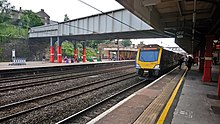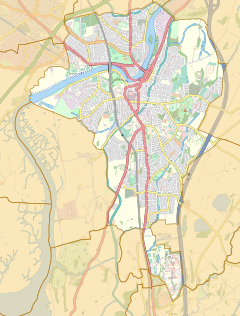| Lancaster[REDACTED] | |||||
|---|---|---|---|---|---|
 | |||||
| General information | |||||
| Location | Lancaster, City of Lancaster England | ||||
| Coordinates | 54°02′56″N 02°48′26″W / 54.04889°N 2.80722°W / 54.04889; -2.80722 | ||||
| Grid reference | SD472617 | ||||
| Managed by | Avanti West Coast | ||||
| Platforms | 5 | ||||
| Other information | |||||
| Station code | LAN | ||||
| Classification | DfT category B | ||||
| History | |||||
| Original company | Lancaster and Carlisle Railway | ||||
| Pre-grouping | London and North Western Railway | ||||
| Post-grouping | London, Midland and Scottish Railway | ||||
| Key dates | |||||
| 22 September 1846 | Opened as Lancaster Castle | ||||
| 1902 | Remodelled | ||||
| 5 May 1969 | Renamed Lancaster | ||||
| Passengers | |||||
| 2019/20 | |||||
| Interchange | 0.384 million | ||||
| 2020/21 | |||||
| Interchange | | ||||
| 2021/22 | |||||
| Interchange | | ||||
| 2022/23 | |||||
| Interchange | | ||||
| 2023/24 | |||||
| Interchange | | ||||
| |||||
Lancaster railway station (formerly known as Lancaster Castle railway station) is a railway station that serves the city of Lancaster in Lancashire, England. It is one of the principal stations on the West Coast Main Line. It is located 20 miles 78 chains (33.76 km) from Preston and is the zero point for mileages onward to Carlisle.
History

Originally known as 'Lancaster Castle Station' in order to distinguish it from the first Lancaster Station (1840–1849), Lancaster station was officially opened on 21 September 1846. The first public service ran into the station on 17 December the same year. The station was built as the southern terminus of the Lancaster and Carlisle Railway after the initial planned route for the line - which would have followed the Lancaster Canal and crossing the River Lune from Ladies Walk to Skerton - was changed in favour of a cheaper route west of the city.
The station was remodelled in 1900-1906 when additional lines and platforms were added and further station buildings constructed. The new buildings were styled mock-Elizabethan with the intention of mirroring the battlements of the nearby Lancaster Castle. Platforms 5 and 6 (on the east side of the station) were electrified in 1908 to serve the now-closed Midland Railway route to Morecambe and Heysham. This line closed in January 1966 and the overhead line equipment was removed.
The track layout in the station area was rationalised in 1973 when control of the signalling was transferred to the new Preston Power Signal Box. This included the removal of the track from Platform 6, although this platform had seen no regular use for some time prior to this. The West Coast Main Line through Lancaster was electrified in 1974, and regular electric passenger services recommenced at the station 7 May 1974.
In 2023, upgrades to the platforms canopies were announced as part of a £9.5 million investment into the station, with work continuing into 2025.
Description
The main building constructed in 1846 by William Tite was situated on the west side of the line in Tudor Revival style using roughly squared sandstone rubble. This two-storey building was extended southwards in 1852 in similar style although this section terminated in a tower of three storeys. A new entrance was constructed in 1900 on the eastern side of the line at footbridge level; this is nearer the town and houses the remaining ticket office.
The booking office is open throughout the week, closing only in the late evening (ticket machines are also available). A full range of facilities is offered, including a newsagents whilst there is also a buffet, waiting rooms and toilets on both sides and lifts between the footbridge and platforms. The station is therefore fully accessible for disabled passengers. The entrance through the original building remains open. This opens onto Platform 3 which is mostly used by northbound services. Two bay platforms to the north of this are used by terminating trains off the various branches to Heysham Port, Barrow-in-Furness and the Cumbria Coast Line, Morecambe, Windermere and Leeds.
Two through lines without platforms separate these three platforms from the remainder of the station; these are used by non-stop passenger services and freight trains. Beyond is Platform 4, which is the principal one used by southbound trains but as with platform 3 it can be used for trains going on both directions. This is an island platform with a second face, Platform 5, which can be used by both northbound and southbound trains or by terminating services. All platforms are signalled for arrivals and departures in either direction. Opposite Platform 5 are the remains of Platform 6 which has no track and has been out of use for many years.
Services

Lancaster is served by several train operators.
Avanti West Coast operate express trains from London Euston to Edinburgh Waverley and Glasgow Central using Class 390 Pendolinos, and Class 221 Super Voyagers. Early morning or late evening services to/from Edinburgh/Glasgow Central or Carlisle or Lancaster start or terminate at Birmingham New Street or Wolverhampton and peak services to and from London Euston terminate and start at Lancaster or Carlisle. A few services to/from Crewe also terminate/start at Lancaster. These services normally use platforms 3 and 4.

TransPennine Express operate regional express services from Manchester Airport, Liverpool Lime Street and Preston to Edinburgh and Glasgow Central via the West Coast Main Line using Class 397 EMUs. These services also use platforms 3 and 4.

Northern operate local & regional services along the Furness line to Barrow-in-Furness and then onto Carlisle via the Cumbrian Coast line, to Windermere via Oxenholme and the Windermere branch line (since the April 2016 franchise changeover), the Morecambe branch line to Morecambe and Heysham and the Leeds–Morecambe line to Skipton and Leeds. These services are operated using DMUs of Classes 150, 153, 156, 158 and 195s. Through services use the same platforms as Avanti West Coast and TransPennine Express trains, whilst those starting & terminating here mostly use platforms 1, 2 and 5. One Northern Trains service a day travels to Morecambe via Carnforth, with some trains continuing to Heysham Port to connect with the Isle of Man Steam Packet Company's ferry service to Douglas. Nuclear flask trains serving Heysham power station are the other main users of the Heysham branch.
| Morecambe, Lancaster and Heysham Port | |||||||||||||||||||||||||||||||||||||||||||||||||
|---|---|---|---|---|---|---|---|---|---|---|---|---|---|---|---|---|---|---|---|---|---|---|---|---|---|---|---|---|---|---|---|---|---|---|---|---|---|---|---|---|---|---|---|---|---|---|---|---|---|
| Legend | |||||||||||||||||||||||||||||||||||||||||||||||||
| |||||||||||||||||||||||||||||||||||||||||||||||||
| Northern Trains Route 6 |
|---|
| Cumbrian Coast, Furness & Windermere lines |
| Braystones & Nethertown are request stops. |
| Northern Trains Route 7 |
|---|
| Settle & Carlisle & Bentham lines |
See also
References
- ^ Butt, R. V. J. (October 1995). The Directory of Railway Stations: details every public and private passenger station, halt, platform and stopping place, past and present (1st ed.). Sparkford: Patrick Stephens Ltd. p. 138. ISBN 978-1-85260-508-7. OCLC 60251199. OL 11956311M.
- Yonge, John; Padgett, David; Szwenk, John (August 2013) . Bridge, Mike (ed.). Railway Track Diagrams 4: Midlands & North West (3rd ed.). Bradford on Avon: Trackmaps. maps 28A, 28C, 29A, 29B, 29C. ISBN 978-0-9549866-7-4.
- ^ "Railway Station Building, Lancaster". British Listed Buildings. Archived from the original on 2 April 2015. Retrieved 3 March 2015.
- "£9.5m scheme to renovate platform canopies at Lancaster station". The Westmorland Gazette. 20 March 2023. Retrieved 13 August 2024.
- Lancaster station facilities Archived 1 December 2016 at the Wayback Machine National Rail Enquiries
- "Scheduled timetable book for 11 December 2022 to 20 May 2023" (PDF). Avanti West Coast.
- "Scheduled timetable book for 21 May 2023 to 9 December 2023" (PDF). Avanti West Coast.
- GB eNRT December 2015 Edition, Table 82 (Network Rail)
- GB eNRT December 2019 Edition, Tables 42, 82 and 98 (Network Rail)
External links
- Train times and station information for Lancaster railway station from National Rail
- Lancaster Stations
- Railway stations in Lancaster
- DfT Category B stations
- Former Lancaster and Carlisle Railway stations
- Railway stations in Great Britain opened in 1846
- Railway stations served by TransPennine Express
- Railway stations served by Northern
- Railway stations served by Avanti West Coast
- 1846 establishments in England
- Grade II listed buildings in Lancashire
- William Tite railway stations
- Stations on the West Coast Main Line



